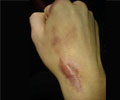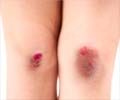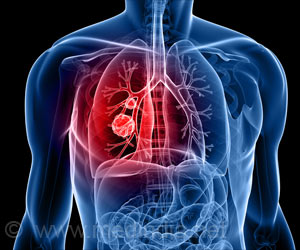Hydrogen peroxide is a familiar bottle in our first aid kits that is used occasionally for cleaning scraped knees and cut fingers.

A burst of hydrogen peroxide causes neutrophils, the immune system's first responders, to rush to the wound to fight microorganisms, remove damaged tissue and then start the inflammation process.
University of Wisconsin-Madison researchers now have discovered the molecular sensor that detects wound-induced hydrogen peroxide and orchestrates the marshaling of neutrophils and other immune cells, or leukocytes, including those that affect tumors.
Published in the Nov. 20, 2011, advanced online version of the journal Nature, the findings have broad implications for cancer biology as well as wound healing and the way the body fights infections.
"Our findings suggest that in the future we might be able to manipulate the new pathway we've found to make immune cells go where we want them to," says lead author Dr. Anna Huttenlocher of the UW School of Medicine and Public Health (SMPH).
A tumor is a type of unhealed wound, says Huttenlocher. Tumors and wounds both generate high levels of hydrogen peroxide, and immune cells responsible for inflammation seek out wounds as well as tumors.
Advertisement
"We now speculate that the recruitment of immune cells for wound healing and tumor growth involves a different molecular pathway than recruitment of immune cells for fighting infections," says Huttenlocher, SMPH professor of pediatrics and of medical microbiology and immunology.
Advertisement
They found that hydrogen peroxide modified a protein called Lyn, and that the modification let neutrophils go to wound sites along a specific cellular pathway.
"If we blocked Lyn, it's possible cells could still get to infection sites, where they could be helpful, but not to wounds or tumors, where they could be harmful," Huttenlocher says.
The experiments showed clearly that Lyn activation was dependent on hydrogen peroxide after tissue injury, and that blocking Lyn reduced the recruitment of neutrophils to wounds. Lyn is expressed specifically in leukocytes as a sensor for hydrogen peroxide.
Lyn is also a member of a powerful class of proteins known as Src family kinases (SFKs). Many of these kinases have been identified as cellular oncogenes, or precursors to cancer.
"Lyn bridges SFKs and the new pathway we have identified, broadly linking wound healing and immunity to changes in cell behavior in cancer," says Huttenlocher. "That connection may help move us forward with a better understanding of wound healing and cancer."
Lyn's connection to hydrogen peroxide should also elevate the chemical's status from the back of the medicine cabinet to a position of much greater interest.
Source-Eurekalert













